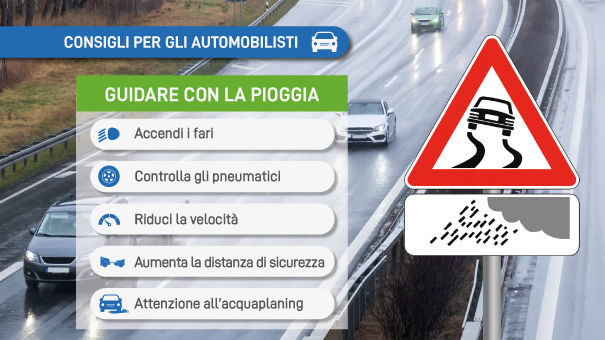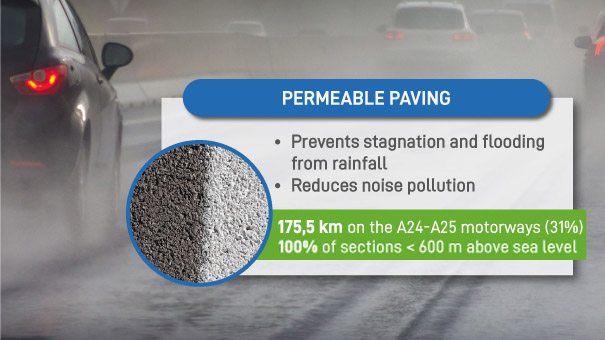With the arrival of fall, rain becomes a frequent companion on our highway journeys. Driving in these conditions requires greater attention and caution to prevent dangers and hazards. Wet roads reduce traction and visibility, making it essential to take certain precautions. Here is a practical guide to traveling safely in the rain.
Maximum attention and no distractions
When weather conditions worsen, it is essential to focus exclusively on driving. Put your cell phone away and turn down the radio volume. Always keep your hands on the steering wheel and maintain a constant overview, checking not only the road ahead but also what is happening behind and to the sides, using rearview mirrors and side mirrors.
Turn on your low beams
In rainy conditions, even in broad daylight, the use of low beam headlights is a must. This expedient not only improves your visibility, allowing you to see the road better, but also makes your vehicle more visible to other road users, reducing the risk of accidents.
Increase the safety distance
Wet road surfaces drastically reduce friction between the tires and the asphalt, lengthening braking times. For this reason, it is essential to double or even triple your normal stopping distance from the vehicle in front of you. This will give you more time to react to any unforeseen incidents.
Reduce speed
In rainy weather, the speed limit on Italian highways is lowered from 130 km/h to 110 km/h. Observing this rule is crucial to preventing danger and maintaining vehicle control in adverse weather conditions.
Pay attention to aquaplaning
This dangerous phenomenon occurs when a “water cushion” forms between the tire and the asphalt. The water lifts the tire, causing it to lose grip and traction. The vehicle “floats” on the surface of the water, making it impossible to brake or steer. The greater the speed and thickness of the water, the more the effect is amplified. If you sense that your car is beginning to lose grip, do not brake abruptly or make sudden movements. Gently lift your foot off the accelerator and hold the steering wheel firmly, letting the vehicle slow down on its own until the tires regain contact with the asphalt.
Beware of brakes
Remember that brakes can lose effectiveness in contact with water. Avoid hard braking and, if possible, slow down gradually to maintain steady control of the vehicle.
Special attention at night
Driving in the rain at night requires even more attention. The glow of drops on windows can camouflage the lights of vehicles or motorcycles, making them difficult to spot. Keep your full concentration on the road and other vehicles.

Prepare the vehicle before leaving
Before you hit the road, always check the maintenance status of your car:
- windshield wipers: if the blades are worn, replace them right away;
- tires: the minimum depth of tread grooves must be at least 3 mm for summer tires and 4 mm for winter tires;
- Air conditioning: an efficient system helps to prevent condensation on the glass when there is a temperature change.
Commitment to safety: the role of permeable paving
Dealing safely with adverse weather conditions on mountain highways such as the A24 and A25 is a priority. This requires not only constant maintenance, but also significant investment in cutting-edge technology. A concrete example of this commitment is the extensive use of drainage pavement, an innovative solution that dramatically improves road safety.
What it is and how it works
Permeable pavement is not a simple asphalt. It is a special asphalt surface characterized by a porous structure with a high percentage of interconnected voids. This unique feature of the surface allows rainwater not to stagnate on the surface, but to drain rapidly through the underlying layers. The result is a road surface that remains dry even under heavy downpours, eliminating the risk of flooding, surface runoff and, most importantly, the danger of aquaplaning.In addition to its fundamental role in preventing the formation of water films, this type of asphalt offers an additional benefit: it reduces noise pollution. In fact, its porosity absorbs some of the noise generated by tire rolling, contributing to a quieter environment.
The spread on the A24 and A25 network.
Strada dei Parchi has invested heavily in this technology. Today, drainage pavement covers 174.5 km of the A24/A25 network, or 31 percent of the total (562.8 km). The commitment is even more evident when one considers thatthis technology has been installed on 100% of the sections where it is technically applicable.

In fact, for technical reasons related to extreme weather conditions, such as severe temperature changes and sudden frosts, permeable pavement can only be applied at elevations below 600 meters above sea level. Despite these limitations, the A24 and A25 highways are a virtuous example of how safety can be maximized even in a mountainous context, which presents unique challenges and requires continuous maintenance and innovation efforts.
With the permeable pavement, combined with prudent driving tips, every trip on the A24 and A25 highways becomes not only safer, but also more serene.







